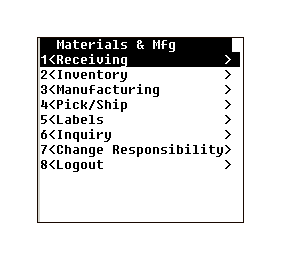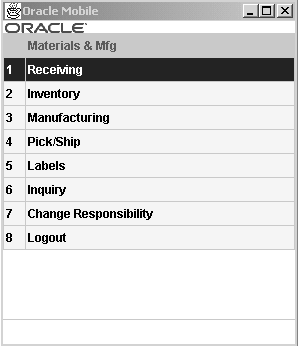Oracle Warehouse Management Overview
This chapter covers the following topics:
- Overview of the Oracle Warehouse Management System
- Inbound Logistics
- Inventory, Storage, and Facility Management
- Oracle Warehouse Management Value Added Services
- Outbound Logistics
- Reverse Logistics
- Warehouse Configuration
- Container and License Plate Management
- Oracle Warehouse Management Rules Engine
Overview of the Oracle Warehouse Management System
Oracle Warehouse Management system is a component of Oracle's Supply Chain Management and Manufacturing solution. It spans the areas of warehouse resource management, warehouse configuration, task management, advanced pick methodologies, and value added services.
Oracle Warehouse Management optimizes the material handling business processes for warehouses, manufacturing facilities, and distribution centers. Oracle Warehouse Management supports both paper-based and automated environments with material handling systems and radio frequency (RF) hand-held computers. To optimize the order fulfillment process, Oracle Warehouse Management provides advanced distribution processes, such as value-added services, cross docking, order assembly postponement, and resource and task management.
Oracle Warehouse Management also provides an easy-to-use interface for mobile, wireless hand-held computers. Mobility, process automation, and bar code scanning greatly improve the efficiency of the Supply Chain Logistics business processes.

The Oracle Warehouse Management functionality spans the supply chain inventory management spectrum. Specifically, Oracle Warehouse Management addresses the following supply chain inventory management components:
-
Inbound Logistics: Includes receiving directly into inventory, receipt inspections, label printing, and rules-based directed put away to storage or opportunistic cross docking
-
Storage and Facility Management: In addition to Oracle's suite of Mixed Mode Manufacturing storage and facility management module, Oracle Warehouse Management extends intra-organization replenishments, container management, storage space optimization, cycle counting and physical inventory, and physical warehouse mapping.
-
Value Added Services: Includes labeling, packing, and kitting
-
Outbound Logistics: Includes picking, staging, packing, product consolidation, loading, and shipping
-
Reverse Logistics: Includes product returns, refurbishment, and recycling
Mobile User Interface
You can view all mobile windows with either the graphical user interface, or the character- mode interface. The interfaces display the same information, and the graphical user interface displays information similar to the desktop application. The following figures depict the mobile user interfaces.


Related Topics
Overview of Oracle Quality, Oracle Quality User's Guide
Overview of Project Manufacturing, Oracle Project Manufacturing User's Guide
Inbound Logistics
Oracle Warehouse Management supports receipt of purchase orders and internal requisitions, return material authorizations (RMAs) and inter-organization shipments in each of three receipt routing methods:
Advanced shipment notices (ASNs) offer a form of collaboration that speeds the receiving process by enabling the receiver to check in entire inbound loads, without entering individual line information. ASNs may contain such information as purchase order number, item number, item serial number, and item lot number.
After products are received, Oracle Warehouse Management can direct users to a dynamically determined staging location based on predefined business rules and strategies. For example, a rule might specify that an item be put away based on the temperature required for storage, hazardous storage requirements, or product velocity.
If a shortage situation occurs, the system might direct you to immediately cross dock the item, versus putting it away to a regular storage location.
The following table provides a summary of the inbound logistics tasks supported by Oracle Warehouse Management.
| Inbound Logistics Tasks |
|---|
| Receiving with or without ASNs |
| Receipt check-in |
| Quality control inspection |
| Bar code printing |
| Directed put-away and storage optimization |
| Opportunistic cross docking |
Inventory, Storage, and Facility Management
Oracle Warehouse Management provides advanced materials visibility and expedited material movement for inventory control. Oracle Warehouse Management also provides license plate tracking throughout the warehouse. Also, the inventory tracking capabilities provided by Oracle Inventory, Receiving, Shipping, and Work in Process applications, Oracle Warehouse Management provides advanced lot and serial attribute tracking and visibility, material status control, and advanced space utilization capabilities.
The following table provides a summary of the inventory, storage, and facility management tasks supported by Oracle Warehouse Management.
Related Topics
Explaining License Plate Management
Material Setup, Oracle Warehouse Management Implementation Guide
Warehouse Setup, Warehouse Management Implementation Guide
Oracle Warehouse Management Value Added Services
All manufacturing modes supported by the Oracle Agile Manufacturing suite of products are supported in Oracle Warehouse Management. This means that with Oracle Warehouse Management you can take advantage of mixed modes of manufacturing in assembly–from Project Manufacturing to kitting and dekitting.
The following table provides a summary of the value added services supported by the system.
| Value Added Services |
|---|
| Kitting and dekitting |
| Customer compliance labeling |
| Mixed-mode manufacturing |
Related Topics
Outbound Logistics
Oracle Warehouse Management automates and helps manage warehouse picking tasks. These tasks include the following:
-
Assigning tasks to pickers, according to various business practices
-
Suggesting pick locations based on picking strategies that are configured using the Oracle Warehouse Management rules engine
-
Interfacing with compliance labeling systems to generate labels according to customer- or carrier-preferred format
The following table provides a summary of the outbound logistics tasks supported by Oracle Warehouse Management.
Related Topics
Reverse Logistics
Oracle Warehouse Management enables you to perform the following reverse logistics tasks:
Oracle Warehouse Management enables you to record and transact returns of material packed into a Licence Plate Number (LPN) using the return to vendor feature. You can also provide LPN based receiving corrections. LPN based returns can be initiated through the desktop forms or transacted through the mobile device interface by scanning the LPN to be returned. Corrections can be made directly through the desktop forms to immediately update information.
Oracle Warehouse Management offers a one step or a two step process for returns. This option is determined by the WMS:Express Returns profile option. By enabling this option you can perform a two step return process where, for example, a manager can initiate the return (step 1) and a picker can retrieve the material and deliver it to shipping (step 2). Otherwise the return transaction is initiated and completed in one step.
For more information refer to the Oracle Purchasing User's Guide.
Related Topics
Returns,, Oracle Purchasing User's Guide
Corrections, Oracle Purchasing User's Guide
Warehouse Configuration
Oracle Warehouse Management uses the same warehouse, resource, trading partner, and material configuration employed by the rest of the Oracle eBusiness Suite. These entities enable users to define inventory organizations, physical areas within the facility, and inventory locators, as well as material valuation cost groups–that are used to track inventory costs, departments within a facility, and the resources (both people and machines) that perform warehouse tasks, such as material movement and value added services. Oracle Warehouse Management uses the following to help manage your warehouse:
Container management enables you to track the contents of any containers in receiving, inventory, shipping, and intransit inventories. The rules engine enables you to set up task strategies that optimize warehouse execution and management.
Related Topics
Warehouse Setup, Oracle Warehouse Management Implementation Guide
Container and License Plate Management
Oracle Warehouse Management provides full visibility to inventory items that are stored in license plate numbers (LPNs). An LPN, in Oracle Warehouse Management, is any object that exists in a location and holds items. An LPN might be a container, but it does not need to represent a physical entity. It could be as simple as a label on a collection of items. Oracle Warehouse Management enables users to track, transact, and nest LPNs and their contents.
Using License Plate Numbers
Using LPNs, you can do the following:
-
Receive, store, and pick material by LPN
-
View on-hand balances by LPN
-
View contents of LPN, including item number, serial number, quantity, and so on
-
Move multiple items in a transaction by the LPN
-
Perform WIP completions into prepacked LPNs
-
Complete work orderless completions or discrete job completions into LPNs
-
Print labels and reports for referencing container contents
-
Track nested LPNs (for example, cartons on a pallet)
Summary of Container Management Features
Oracle Warehouse Management container management enables you to:
-
Use a unique LPN, identify a container and its contents
-
Pack and unpack LPN contents
-
Receive inventory into LPNs from suppliers and internal organizations
-
Move, and transact inventory in LPNs
-
View LPN contents
-
View the on-hand quantity packed in an LPN
-
Print LPN labels
Related Topics
Explaining License Plate Management
Oracle Warehouse Management Rules Engine
The Oracle Warehouse Management rules engine is a modeling tool whose repository of business practices and restrictions enable it to suggest the best process for a particular warehouse function. You can set up rules and strategies to do the following:
-
Enable the system to allocate material for picking (directed picking)
-
Enable the system to suggest put away locations in which to store an item (directed putaway)
-
Enable the system to assign material valuation and holding accounts to received material (cost group assignment)
-
Enable the system to suggest the label format and information content that are used to print a given label (compliance labeling)
-
Designate warehouse
-
Designate which operation plan to use for consolidation.
All of these features increase your ability to manage your warehouses more efficiently.
Directed Picking and Putaway
Oracle Warehouse Management directed picking and putaway enables you to dynamically select storage locations for material that is received into the warehouse, or completed from WIP, and to allocate material for sales orders based on user defined material selection criteria.
Cost Group Assignment
If your company holds inventory on their premises, you can use the cost group assignment feature to view the ownership associated with inventory. A separate cost group is warranted whenever an item has a different account coding. Thus, a supplier's warehouse inventory can be identified, tracked, and properly costed, even if it is commingled with your company's inventory. The cost group assignment feature helps reduce physical inventory levels, while promoting higher inventory turns.
Compliance Labeling
Oracle Warehouse Management enables you to suggest a label format based on the customer, item, order type, carrier, or other entities related to the material.
The actual printing of the label is performed by a third party label printing system. Label generation and format selection are performed within Oracle Warehouse Management, either at predetermined points in the business process, or at user request.
Task Dispatching
The rules engine identifies the correct task type for system generated tasks so that they can be assigned to a qualified user with the appropriate equipment.
Operation Plan Selection
The rules engine identifies the correct operation plan to use for consolidation. Operation plan selection rules correspond to the three modes of consolidation: LPN, Locator, and LPN and Locator.
If LPN based consolidation is selected, all picked material that has to be consolidated together are directed to be dropped into the same License Plate Number. If Locator based consolidation is selected, picked material is consolidated into locators. If Locator and LPN based consolidation is selected, picked material is consolidated into locators. In addition, it also provides consolidation LPN suggestions within the consolidation locators.
Related Topics
Overview of the Oracle Warehouse Management Rules Engine
Corrections, Oracle Purchasing User's Guide
Returns, Oracle Purchasing User's Guide